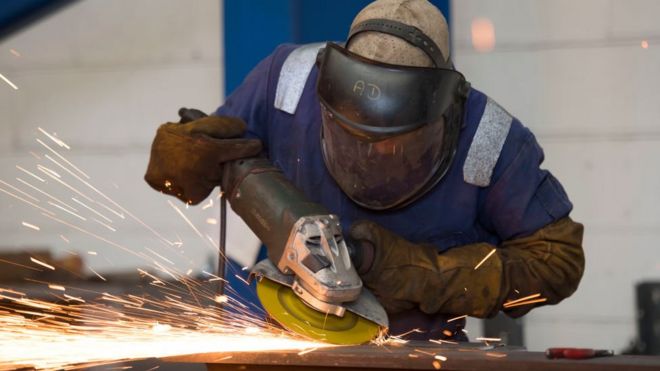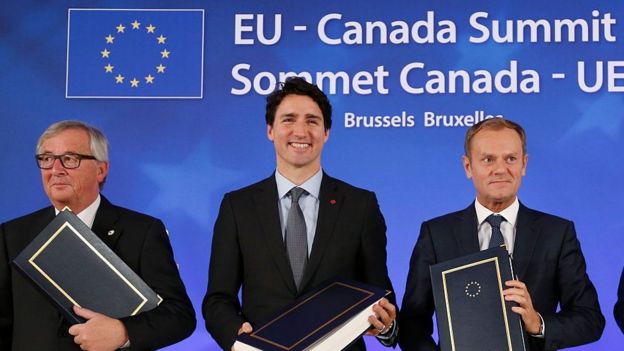 GETTY IMAGES
GETTY IMAGES
The UK is no longer a member of the European Union (EU), which means it's now free to negotiate and sign trade deals around the world.
Securing a UK-EU trade deal will be top a priority over the months ahead. But what are free trade deals and why does the UK need them?
What is a trade deal?
A trade deal aims to increase trade between countries - usually in goods, but occasionally in services too.
Making it cheaper to trade between countries is one way of doing this. A free trade deal will often reduce or eliminate tariffs - charges for bringing certain products across borders.
Trade agreements also aim to remove quotas - these are limits on the amount of goods that can be traded.
Trade can also be made simpler and faster if countries have the same rules, such as the colour of wires in plugs. The closer the rules are, the less likely goods need to be checked to make sure they meet the required standard.
So why have tariffs and quotas at all?
While free trade agreements aim to boost trade, too many cheap imports could threaten a country's manufacturers.
So in order to protect local car makers, for example, a country could impose tariffs on vehicles from other parts of the world.
Why does the UK need an EU trade deal?
The UK will need to secure an agreement with the EU to stop new tariffs and other trade barriers coming into force after the transition period ends on 31 December 2020.
During the transition period the UK will still be part of the EU's trading arrangements - the single market and the customs union. That means no tariffs, quotas or checks will be introduced.
Where does the UK trade?
% of total UK trade in 2018
The point of the transition is to give both sides some breathing space while the trade deal is negotiated, and to give businesses time to get ready.
If any trade deals are reached, either with the EU or other countries, they won't start until the UK has left the transition.
What about a Canada-style deal?
 GETTY IMAGES
GETTY IMAGES
Prime Minister Boris Johnson has spoken in favour of an EU trade agreement that builds on the deal that Canada currently has with the EU.
Tariffs on most Canadian goods, such as machine parts, have been eliminated, although there are some additional checks (such as customs and VAT).
Services, like banking, are much more restricted.
The financial sector is very important to the UK economy - so getting a deal in this area will be a priority in the talks.
How easy will it be to negotiate a UK-EU trade deal?
Neither side wants tariffs and quotas - so that part of the trade deal could be straightforward.
But getting agreement around rules and regulations could be much tougher.
The UK and the EU begin the negotiations with exactly the same rules - from the financial help companies are allowed to get from governments, to the way wine is labelled.
If the UK moves away from some of these rules, it might make it easier for it to secure trade deals with other countries, like the US.
The EU, on the other hand, wants to keep close alignment with the UK, to prevent its companies gaining a competitive advantage.
But even if a detailed trade deal is agreed, it won't eliminate all checks. That's because the EU requires certain goods (such as food) from non-EU countries to be checked, no matter how closely they follow EU rules.
Time is also a problem. The transition is due to end on 31 December, and formal trade talks are not likely to start until early March. That's because the EU needs to agree its negotiating objectives among its 27 members first.
What happens if UK-EU trade talks fail?
If negotiators fail to reach a deal in time, then the UK faces the prospect of trading with the EU under the basic rules set by the World Trade Organization (WTO), which is where countries negotiate the rules of international trade.
If the UK had to trade under WTO rules, tariffs would be applied to most goods which UK businesses send to the EU. The worry for companies is that this would make their goods more expensive, and harder to sell in Europe.
Trading on WTO terms would also mean full border checks for goods, which could cause traffic bottlenecks at ports, such as Dover.
And the UK service industry would lose its guaranteed access to the EU single market.
That would affect everyone from bankers and lawyers, to musicians and chefs.
What trade deals has the UK done so far?
While it was an EU member, the UK was automatically part of around 40 trade deals the EU had struck with more than 70 countries.
In the run-up to Brexit, the UK was given permission to replicate these agreements. So far, the UK has managed to roll over 20 "continuity" deals, covering 50 countries or territories:
- Kosovo (trade worth £8m in 2018)
- Jordan (trade worth £448m in 2018)
- Morocco (trade worth £2.5bn in 2018)
- Georgia (trade worth £123m in 2018)
- Southern African nations (trade worth £10.2bn in 2018)
- Tunisia (trade worth £542m in 2018)
- Lebanon (trade worth £762m in 2018)
- South Korea (trade worth £14.8bn in 2018)
- Central America (trade worth £1.1bn in 2018)
- Andean countries (trade worth £3.4bn in 2018)
- Norway and Iceland (trade worth £30.6bn in 2018)
- Caribbean countries (trade worth £3.7bn in 2018)
- Pacific Islands (trade worth £163m in 2018)
- Liechtenstein
- Israel (trade worth £4.2bn in 2018)
- Palestinian Authority (trade worth £41m in 2018)
- Switzerland (trade worth £32.4bn in 2018)
- The Faroe Islands (trade worth £252m in 2018)
- Eastern and Southern Africa (trade worth £2bn in 2018)
- Chile (trade worth £2bn in 2018)
How much are these trade deals worth?
In 2018, the total value of UK trade (goods and services) was £1.3tn. About 11% of this trade came from countries with EU trade agreements.
The 20 trade agreements the UK has reached represent just over 8% of total UK trade. That means the UK has so far rolled over about three-quarters of the EU's trade deals, based on the 2018 trade figures.


